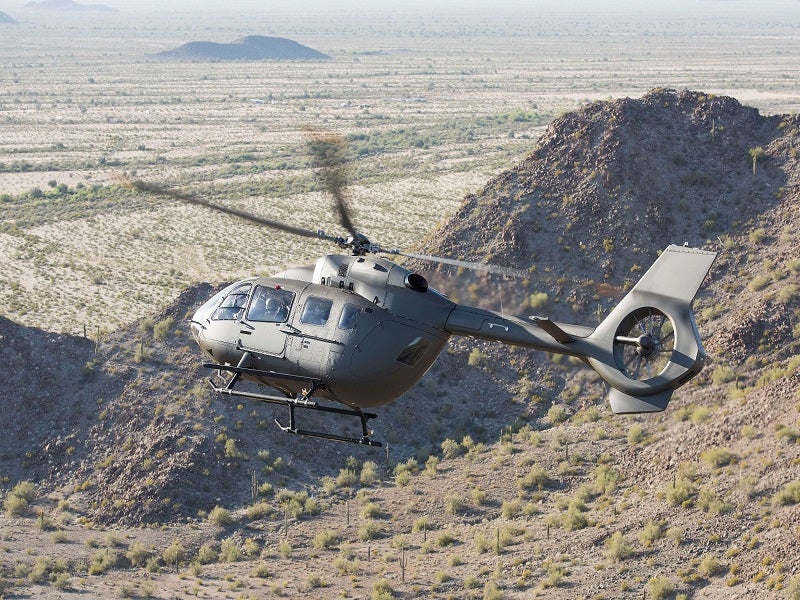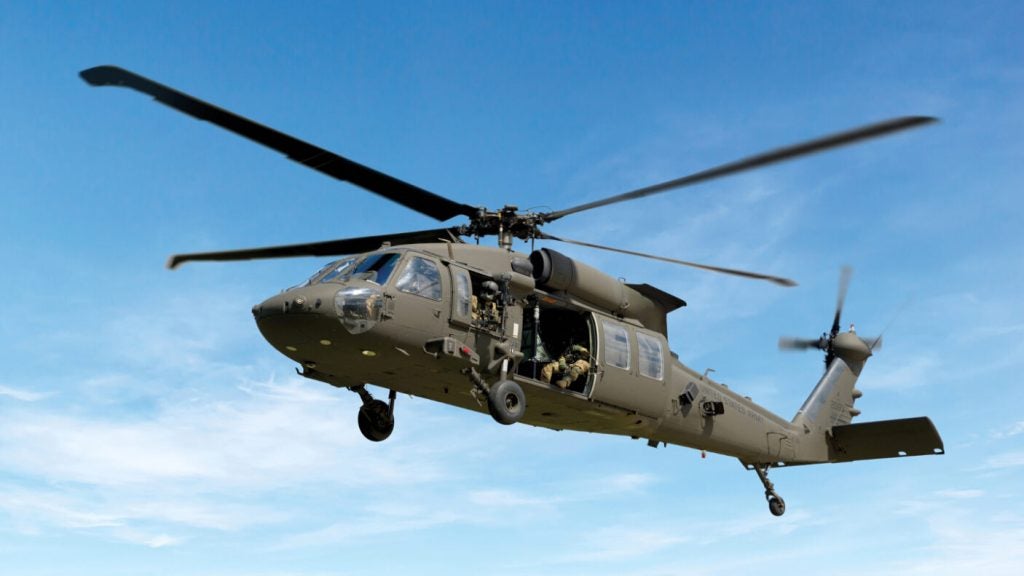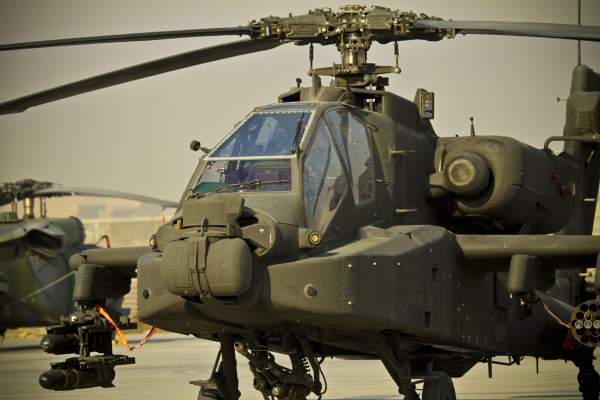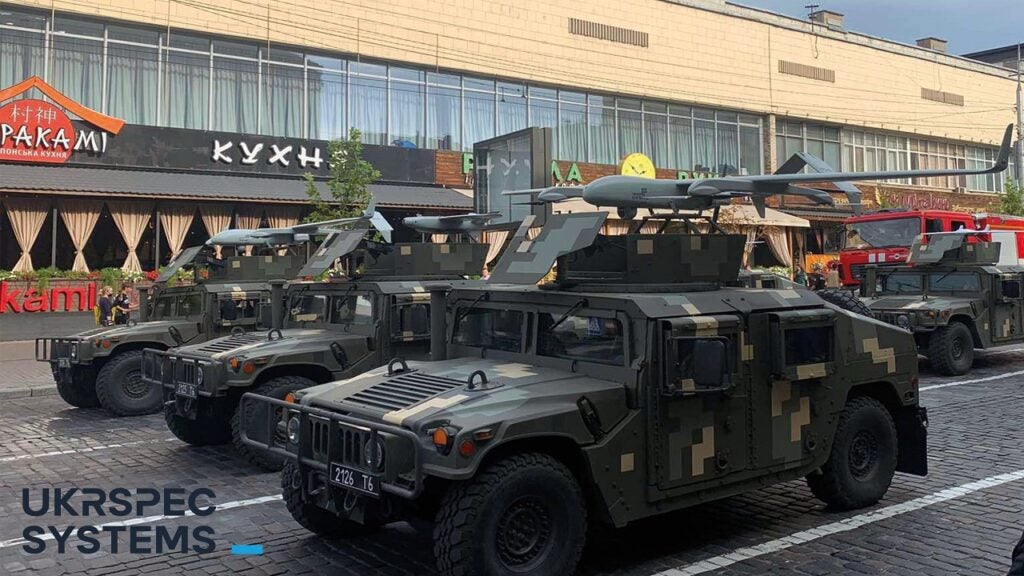The UH-72A Lakota is a light utility helicopter specifically designed to meet the requirements of the US Army. The UH-72A Lakota helicopters were acquired to replace the UH-1H Iroquois and OH-58 A/C Kiowa helicopters.
Based on the EC145 multi-role helicopter, the UH-72A serves the Army principally for logistics and support missions within the US. It is also used by the Army National Guard for homeland security and disaster-response missions and medical evacuations.
The prime contractor for the UH-72A helicopter is EADS North America (now Airbus Group). Airbus Helicopters, a subsidiary of Airbus Group, is involved in managing production, assembly, delivery and training the army.
Airbus handed over the 463rd UH-72A to the US Army in September 2020. The delivery of the final UH-72A marked the transition of the programme to a more modern variant, UH-72B.
UH-72A Lakota light utility helicopter design
The UH-72A Lakota light utility helicopter is a military version of the Eurocopter EC145. During the competitive bidding phase, EADS North America used the UH-145 designation for its light utility helicopter entry. The helicopters were manufactured by Airbus Helicopters at the company’s production centre in Columbus, Mississippi.
The main and tail rotors are high set to allow fast and safe loading and unloading through the main doors and rear-fuselage clamshell doors, even while the rotors are turning. The helicopter has a hingeless rotor system with composite main rotor blades which are 11m in diameter. The rotor configuration provides reduced noise and vibration characteristics. The high-set, twin-blade tail rotor has a diameter of 1.95m.
Safety features include a high level of redundancy with a twin-engine design, and redundant hydraulic, electrical and engine control systems. The crashworthy airframe and seats also contribute to the UH-72A’s operational safety and survivability.
Cockpit and avionics systems
The cockpit and cabin of the UH-72A Lakota light utility helicopter are fitted with a large multipiece wrap-around front windscreen, multiple side-fuselage windows on the cockpit and passenger doors, and side windows for the main cabin. The windows and windscreen, supplied by Nordam Group in Tulsa, Oklahoma, provide good visibility for the helicopter’s crew and passengers.
The cockpit accommodates a crew of two and is fitted with two Simula energy-absorbing cockpit seats supplied by BAE Systems Mobility and Protection Systems (formerly Armor Holdings Aerospace and Defense Group). The cockpit seats have ergonomic cushions, a four-point restraint system with an inertia reel and are qualified to FAA crashworthiness standards.
UH-72A is fitted with a night-vision goggle-compatible glass cockpit with active-matrix liquid crystal displays and a Meghas avionics suite supplied by Thales US. The cockpit displays include the Thales centralised vehicle and engine management display (VEMD).
The cockpit displays simplify the presentation of flight and vehicle information, increasing the crew’s situational awareness and reducing the pilot’s workload.
Production of the Meghas avionics suite was transferred from Europe to a new Thales production facility in Irvine, California.
The helicopter’s automatic flight control system was supplied by Sagem Avionics and was partially produced at the company’s Grand Prairie, Texas, facility.
UH-72A Lakota light utility helicopter’s automatic flight control system includes two attitude and heading reference systems (AHRS), advanced power management (APM) computers, smart electro-mechanical actuators, TRIM actuators and fibre-optic gyroscopes.
The avionics cooling system, supplied by Keith Products of Addison, Texas, ensures proper operating temperatures for the helicopter’s navigation, communications and mission equipment.
Navigation, communications and cabin of UH-72A
UH-72A Lakota light utility helicopter’s navigation and communications systems were supplied by Wulfsberg Electronics based in Prescott, Arizona. The navigation and air traffic control communications include dual VHF communications transceivers, dual VHF navigation receivers with VOR, ILS and marker beacon, and a DME transceiver.
The UH-72A’s tactical communications system includes an RT-5000 wideband transceiver operating at 29MHz to 960MHz, and dual P-2000 tactical communications transceivers. Wulfsberg Electronics also supplies navigation and communications systems for EC145 helicopters used in civilian and special mission roles.
The cabin accommodates eight troops or passengers. The cabin is fitted with BAE System’s Simula passenger seats which are of fold-up design and meet FAA crashworthiness standards. The cockpit and passenger seats are of high strength, lightweight composites construction and include aramid and graphite materials.
The cockpit and cabin are fitted with a heating and ventilating system supplied by Keith Products. The Keith Products heating, ventilation and cooling systems are fitted as standard equipment for all civilian EC145 versions of the Lakota UH-72A.
Mission systems aboard UH-72A
The modular design of the UH-72A Lakota light utility helicopter allows the fast and efficient installation of a range of mission modules.
For ambulance and medical evacuation missions, the cabin can accommodate two stretchers, plus one crew chief (who is qualified to operate the hoist and other aircraft equipment) and one medical attendant. The UH-72A’s Nato standard stretchers and stretcher retainer mounts were supplied by Aerolite of Washington.
The UH-72A Lakota light utility helicopter has an externally mounted rescue electric hoist, series type 44301 from Goodrich. The hoist is mounted on a boom and support assembly that allows it to be positioned in an arc of up to 63° from the aircraft fuselage centreline for maximum operational flexibility. The hoist is stowed in line with the fuselage during flight.
Turbomeca Arriel 1E2 turboshaft engines and flight training
The helicopter is powered by two Turbomeca Arriel 1E2 turboshaft engines, each providing 550kW of take-off power and 516kW continuous power.
The engines are rated to provide a maximum power of 574kW for two and a half minutes and 404kW continuously in one-engine-inoperable-mode fight.
CAE USA in Tampa, Florida, was contracted to design and manufacture UH-72A cockpit procedural trainers for the US Army, used for procedural, familiarisation, and transition training as the army begins taking delivery of the UH-72A helicopters.
Airbus Group also acquired the UH-72A cockpit procedural trainer to support pilot transition training at the Airbus Helicopters training centre in Grand Prairie, Texas.
UH-72A Lakota light utility helicopter orders and deliveries
A $43.1m contract was awarded to EADS North America in June 2006 for an initial order of eight helicopters. The army took delivery of the first UH-72A Lakota in December 2006. The first eight helicopters were delivered by July 2007. An additional order for 34 helicopters worth $170m was placed in October 2006 for delivery by late 2008.
The Lakota light utility helicopter entered service in June 2007. Full-rate production was authorised in August 2007.
The US Army’s requirement is for a total of 322 helicopters with a potential value of $2bn.
In October 2008, the US Navy placed an order for five Lakotas for training at the Naval Test Pilot School, Patuxent River, Maryland.
In December 2008, the US Army ordered a further 39 Lakotas, extending production to the end of 2010. Five more were ordered in January 2009, bringing the total confirmed order for the army to 128. The 50th and 51st UH-72s were delivered in December 2008.
The US Army received two new UH-72A helicopters in January 2009 to replace its 38-year-old UH-1H Iroquois helicopters. The South Dakota Army National Guard received the first of six UH-72A helicopters in May 2011. The 200th Lakota was delivered to the US Army in March 2012.
In January 2012, EADS North America received a $212.7m contract from the US Army to deliver 39 UH-72A Lakota helicopters.
In November 2012, EADS North America received a $181.8m contract option from the US Army to deliver 34 UH-72A Lakota helicopters, bringing the total orders to 312.
The Utah Army National Guard received two new Lakotas in September 2013.
The US Army placed a $220.5m modification contract with Airbus Helicopters for the delivery of 41 UH-72A Lakota light utility helicopters, in February 2014.
Airbus delivered six UH-72A Lakotas to the Royal Thai Army in 2014 under the US’s foreign military sales programme.
Airbus delivered the first production-line configured UH-72A training helicopter to the US Army in March 2015.
The US Army awarded a $65.8m contract to Airbus for the delivery of 12 additional UH-72A helicopters and associated mission packages in November 2015.
Airbus secured a five-year contract worth approximately $1bn from the Army to provide spare parts and material and engineering support to the UH-72A fleet in December 2016.
The US Army awarded two contracts worth totalling $389m for the delivery of 51 UH-72A Lakota helicopters in March 2018. Airbus delivered the 200th UH-72A Lakota to the Army Aviation Center of Excellence at Fort Rucker, Alabama, in August 2019.
The US Army placed a $122m order for 15 UH-72A Lakota training and support platforms in March 2020, which are scheduled to be delivered by August 2022.
The Utility Helicopters Project Management Office of the US Army received a total of 16 UH-72A helicopters in 2020. In September 2021, Airbus handed over the first UH-72B variant to the US Army National Guard, under a contract with the National Guard to deliver 18 UH-72Bs.
UH-72B upgrade
The UH-72B is the latest variant in the Lakota light utility helicopter series. The main features of the upgraded helicopter include a five-bladed motor rotor, Safran Arriel 2E engines, and Fenestron shrouded tail rotor. The helicopter also incorporates Airbus’ Helionix suite of avionics, which is designed to increase mission flexibility and operational safety.
The suite includes an advanced dual-duplex four-axis autopilot that reduces the pilot workload and provides flight envelope and over-limit protection. It also enables automated take-off of the helicopter.
Contractors involved
EADS North America selected companies such as LCX Systems, Sierra Nevada Corporation (SNC), Ranger Rotorcraft Group, MARK IV Luminator, and L-3 Communications (now L3Harris) for the security and support mission equipment package. The package includes an electro-optical infrared sensor, a data communications suite, moving map display, cabin and cockpit screens, a digital video recorder and a searchlight.
Sikorsky was contracted to supply the UH-72A logistic support, including maintenance contract management, supply chain management, contractor field teams, spare part and tool management, facilities management and field and depot-level maintenance.
Safran Electronics & Defense, Avionics was selected to provide avionics systems for the UH-72A helicopters.








